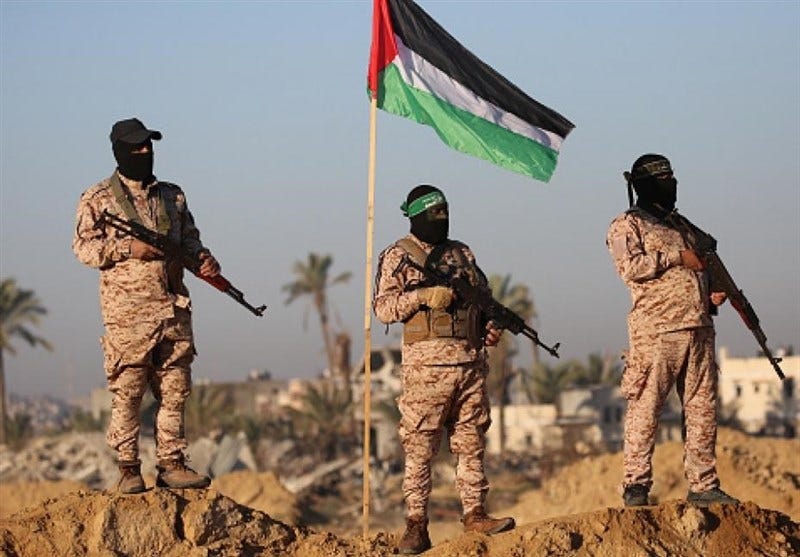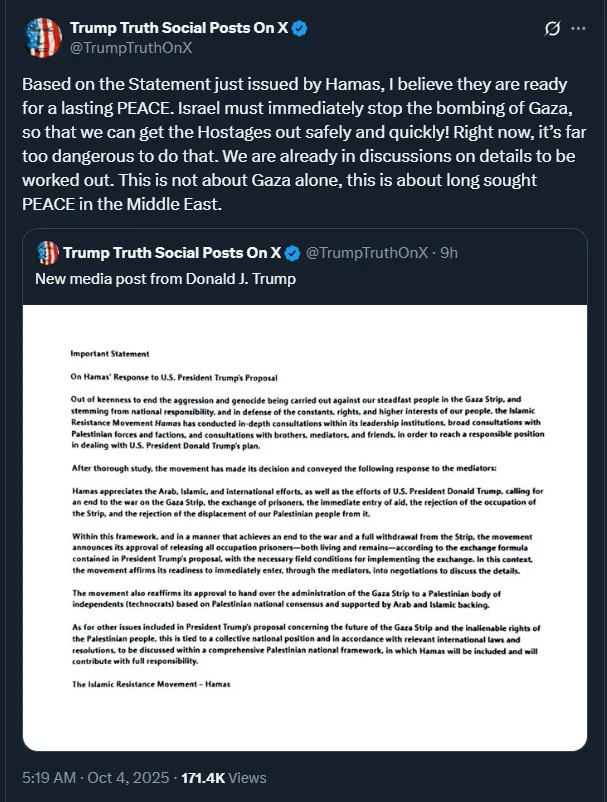A Look at the Dimensions of the Resistance’s Smart Response to Trump’s Plan: How Hamas Broke the Political Siege
Hamas’ responsible yet intelligent response to U.S. President Donald Trump’s plan to end the war in Gaza has confused many observers, including the Zionists.
Palestine, PUREWILAYAH.COM - Hamas, by crafting a response that neither accepts Trump’s plan in its current form nor rejects it outright—and without abandoning any of the Palestinians’ core principles—managed to break the major political siege imposed on the resistance and create new space for maneuvering.
According to Tasnim News Agency, Hamas’ responsible yet intelligent response to U.S. President Donald Trump’s plan to end the war in Gaza has confused many observers, including the Zionists.
While the response rejects most provisions of Trump’s plan, it is designed in such a way that removes Hamas from the shadow of accusations of obstructing the negotiation process. But how was this response developed?
How Hamas Prepared Its Strategic Response
When Trump and Netanyahu jointly unveiled what was essentially an “Israeli plan” during their press conference in Washington—a plan that amounted to a death sentence for Gaza—despair filled the hearts of Palestinians and their supporters.
Netanyahu even released celebratory videos, claiming victory. His war-criminal glee inflamed outrage among free people worldwide. Trump, meanwhile, threatened that if Hamas did not accept his plan, he would unleash “a great hell.”
In the midst of these threats and the escalating aggression, with Turkish, Egyptian, and Qatari officials holding high-security talks in Doha, Hamas began intensive internal consultations with other Palestinian resistance factions.
These discussions focused on finding ways to break the political and diplomatic blockade, create breathing space, or at least buy time.
It must be noted that this was not the first time Hamas had faced such pressure. Throughout the two-year Gaza war, constant international and regional pressure was exerted against the movement. However, amid the ongoing U.S.-backed Israeli military assaults on civilians, the situation became increasingly dire.
Drawing on its political experience, Hamas devised a shrewd approach: it neither rejected Trump’s proposal completely nor accepted it as is. The movement understood that Trump’s plan aimed to isolate and criminalize the Palestinian resistance globally.
Thus, Hamas drafted a carefully worded response to gain both time and flexibility while preserving its principles.
A Tactical Shift on the Prisoner Exchange Issue
Hamas realized that the issue of captured Zionist soldiers had shifted from a pressure card to a tactical burden.
Their presence in Gaza did not deter Israeli bombings or atrocities, as Netanyahu continued his military offensives regardless. This meant that Israel’s leadership had effectively abandoned its own captives, using them only as justification for continued aggression.
Therefore, Hamas concluded that holding onto the prisoners no longer offered strategic advantage—perhaps even becoming a liability. As a result, Hamas agreed to the clause in Trump’s plan concerning the release of Israeli captives, but with a crucial distinction: it refused other demands and insisted that further issues must be negotiated.
After these deliberations, Hamas drafted a masterfully precise statement—calibrated even to appeal to Trump’s ego.
Regional Diplomacy and Global Reactions
Soon after, foreign ministers began contacting one another. Turkish Foreign Minister Hakan Fidan and intelligence chief Ibrahim Kalin spoke with Trump’s special envoy, Steve Witkoff, briefing him on Hamas’ statement. They agreed that Hamas’ response presented a valuable opportunity to end the war.
Then came the difficult part—convincing Trump while bypassing the influence of the Israeli lobby in the White House, Pentagon, and State Department.
Qatari Emir Sheikh Tamim bin Hamad Al Thani called Trump, affirming that the outcome represented the best achievable result. The next day, Turkish President Recep Tayyip Erdoğan also phoned Trump, endorsing the Doha talks’ outcome as the most reasonable path forward.
Trump ultimately recognized that securing the release of Israeli captives could serve as a major political achievement for him. He reacted positively to Hamas’ response.
Hamas’ official statement was then published and, unexpectedly, received broad international welcome. Netanyahu, expecting Trump to reject it, was shocked when Trump publicly announced on social media that “Hamas is ready for lasting peace” and that Israel “must immediately stop the bombing.”
The White House later revealed Trump would deliver a video address, and an image of him recording the speech was released. Although the broadcast was delayed—amid speculation of internal disputes—Trump ultimately issued a short clip reaffirming his support for Hamas’ response after pressure from Witkoff.
Hamas had effectively broken the political blockade and bought valuable time, leaving Israel in an uneasy position.
The United States Forced to Recognize Hamas
In a remarkable turn, both Trump and his vice president posted Hamas’ full statement on their personal accounts.
This shocked U.S. and Israeli political circles—because the same movement long branded as “terrorist” was now being addressed as an official entity.
Zionist Outrage and Media Backlash
Israeli media erupted with outrage, accusing Trump of “selling out Israel for the Nobel Peace Prize.” Commentators noted that Trump had achieved what he wanted—freeing the Israeli captives and scoring a political victory—while Netanyahu failed to destroy Hamas.
These developments coincided with Israel’s assault on the Global Sumud Flotilla, a humanitarian convoy of activists from over 70 countries attempting to break Gaza’s siege. The attack further intensified international public anger against Israel.
Trump, seizing the moment before the October 10 Nobel Peace Prize nomination deadline, welcomed Hamas’ statement and waited to see which countries would officially nominate him.
Neither Victory Nor Defeat
The Gaza Strip, besieged and bombarded for two years—enduring one of the worst humanitarian catastrophes of the modern era—has received neither food nor ammunition from Arab or Islamic countries. Yet, it has mounted one of history’s greatest resistances and, through this political maneuver, secured precious time to regroup.
Hamas, representing the Palestinian people and resistance as a whole, took a rational step that reshaped its global image, regaining psychological and moral initiative.
This moment, though not an outright victory or defeat, marks the beginning of a new phase in the century-long struggle—one in which the Palestinian resistance continues without surrendering its land or dignity.
Despite the enormous price paid in this brutal war, the Palestinian people and their resistance have turned themselves into a global symbol of the fight for freedom—and have kept their cause alive. (PW)
Source: Tasnim News



